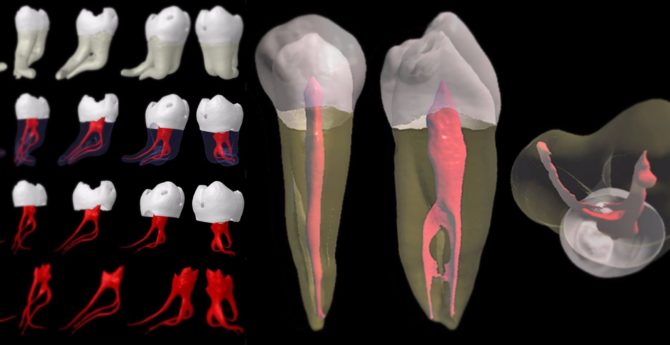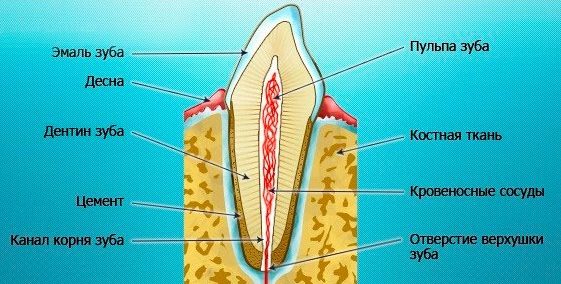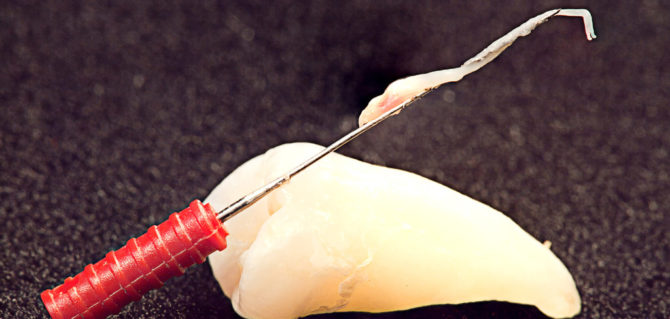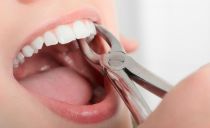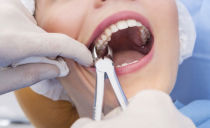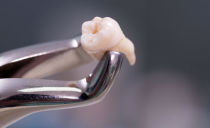Dental nerve removal: how and in what cases are removed, the consequences
Dentists only resort to pulp removal surgery as a last resort, because tooth nerve removal is fraught with negative consequencesassociated with difficulties in its further normal functioning. However, this procedure is quite common and can affect every person.
Content
Where is the nerve of the tooth located and why is it removed?
If we consider the simplified structure of the tooth, then we can distinguish its three main parts:
- Enamel is a strong outer layer that protects the tooth from physical, chemical, temperature and other influences.
- Dentin is the middle shell through which the transfer of nutrients to enamel occurs.
- Pulp is the central part, consisting of nerve fibers and blood vessels.
By the procedure of removing a dental nerve is meant the extraction of soft pulp tissue - depulpation. This procedure is necessary for pulp inflammation, when treatment is impossible or difficult. If the inflammatory process is not eliminated, over time it can spread to neighboring teeth, mucous membranes and go into purulent inflammation.
Usually, the dental nerve is completely removed, but in special cases, partial extraction (amputation) of the pulp is performed. During amputation, the damaged part of the tissues is cut off under the crown with the preservation of the root section, and why the nerve is partially removed from the tooth. Preservation of part of the nerve is necessary so that the enamel continues to receive the necessary nutrients in a natural way.
Indications and contraindications for removal
The nerve is removed from the tooth in situations where it is inflamed, and partial amputation is not possible. The causes of pulp inflammation are most often caused either by the patient's indifferent attitude to oral health, or poor-quality procedures for the treatment of caries and other dental diseases. In which cases the nerve is removed from the tooth:
- Neglected caries. If the patient visits the clinic in a timely manner, the dentist will eliminate the detected carious formations and fill the dental cavities. If caries spreads and penetrates through the dentin, causing inflammation of the pulp, then it will have to be removed.
- Physical injury to the tooth. If the patient goes to the dentistry immediately after the injury, the doctor will be able to disinfect and seal the damaged surface with high quality. Otherwise, the tooth may become inflamed.
- Infectious pulpitis. Inflammation of the pulp can develop when infection penetrates through the root system.
- Chronic pulpitis. Most often detected during a routine examination, as it is asymptomatic.
There are contraindications to nerve removal. In what cases do not remove the nerve from the tooth:
- With poor blood coagulation and hypertension, as the operation in such pathologies is fraught with the discovery of profuse bleeding, which can lead to large loss of blood.
- In acute infectious processes in the oral cavity. Pathogens can penetrate deep into the jaw through the space where the remote nerve was located, and cause serious complications.
- In the first months of pregnancy. During this period, the use of a number of anesthetics is prohibited. In addition, doctors advise pregnant women to avoid any worries and stresses.
Preparation for surgery
Most teeth have a standard structure, but sometimes there are specimens with the original geometry of the roots. Most often this applies to molars. The dentist needs to clearly understand the depth of the roots, otherwise he will not be able to qualitatively carry out the removal of the nerve from the tooth. Therefore, before surgery, patients are often referred for radiography.
The soreness of the process depends on the neglect of the disease, the anesthetic used and the individual sensitivity of the person.
If a person has taken any pain medication before visiting dentistry, he must inform the doctor about it. The nervous system develops resistance to the components of anesthetics, as a result of which the selected local anesthesia may not work.
In the absence of contraindications to general anesthesia, a tooth nerve can be removed in a dream. But such a service is not available in all dental clinics.
When a nerve is removed, saliva can enter the tooth. Therefore, dentists use various methods to isolate the treatment area:
- The standard isolation method is to use cotton turundas;
- modern - in the use of cofferdam - a special film applied to the mucosa around the tooth.
How tooth nerve removal occurs
With timely contact with the clinic and with a simple geometry of the roots of the operated molar nerve removal procedure takes about 20 minutes. Pulp extraction takes place in two stages. First, the doctor removes the tooth tissue affected by caries. Then, by cutting the upper part of the crown, it creates access to the pulp chamber and forms even walls to eliminate possible obstacles when removing the nerve.
Most often, the pulp is killed by laying arsenic or using a pulp extractor. The pulp extractor is similar to a thin embossed metal string that is inserted into the channel and rotated 180 degrees, as a result of which the nerve clings to the teeth of the instrument and is removed. During the procedure, soft tissues come off the periodontal, which sometimes causes bleeding. Therefore, often, instead of the standard pulp extractor, other tools are used, and for strongly bent channels - K-files. Their advantage is that they allow you to remove the fabric by cutting, that is, almost bloodless.
The method of killing pulp with arsenic has been used for a very long time. Its essence lies in the insertion of arsenic anhydride into the cavity of the tooth, which leads to the death of soft tissues. After 2-3 days, the patient is removed dead tissue, and the cleaned canal is filled.
How to remove a nerve from a tooth is shown in the video:
Postoperative regimen
Usually, after drug treatment of the root canals, a temporary filling is placed. Permanent filling is carried out only after some time in the absence of signs of infection of the tooth canals. To quickly heal a wound and minimize the risk of side effects after removing a tooth nerve, the patient should follow these recommendations:
- do not eat within 3-5 hours after surgery;
- do not eat solid food within 3-5 days after the procedure, and also avoid getting cold, hot, spicy food and drinks on the depulped tooth;
- in the first days after the procedure, strong physical exertion, which can cause an increase in blood pressure and, as a result, heavy bleeding in the area where the removed nerve was located, should be avoided;
- comply with the dentist's recommendations for taking anesthetics (painkiller paste or gel) and rinsing the mouth with antiseptics.
After removing the nerve, the tooth may ache and hurt. This is normal if the pain is present for no more than 5 days and does not have a sharp or pulsating character. Otherwise, it is better to seek the help of a dentist.
What will happen to the tooth if the nerve is removed
Due to the loss of access to nutrients, enamel will begin to experience a deficiency in calcium, fluoride and vitamins, which will negatively affect its strength. Enamel porosity will increase, which will lead to the possibility of infiltration of pathogens into the dentinal tissue. To prevent such consequences, dentists recommend a number of procedures, including the use of medical pastes and special gels.
Another consequence of tooth nerve removal is a discoloration of the enamel. Its darkening may be due to a lack of fluorine or the use of such filling material as endometasone when depulping. When using another material - resorcinol-formalin paste - the tooth enamel may acquire a pinkish tint.
Pulp removal surgery is a real surgical procedure. It is prescribed in situations where other methods of treatment are not applicable. The use of modern dental instruments and anesthetics contributes to almost painless nerve removal.
About why the tooth on which the operation to remove the nerve can be hurt, the video says:

